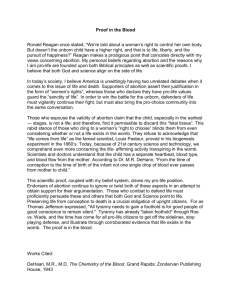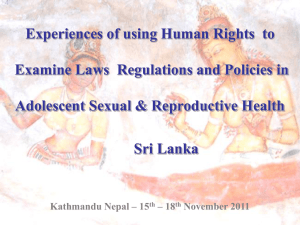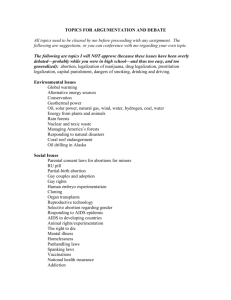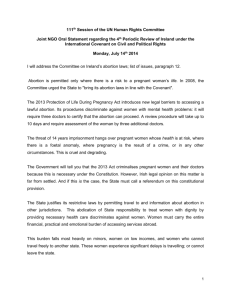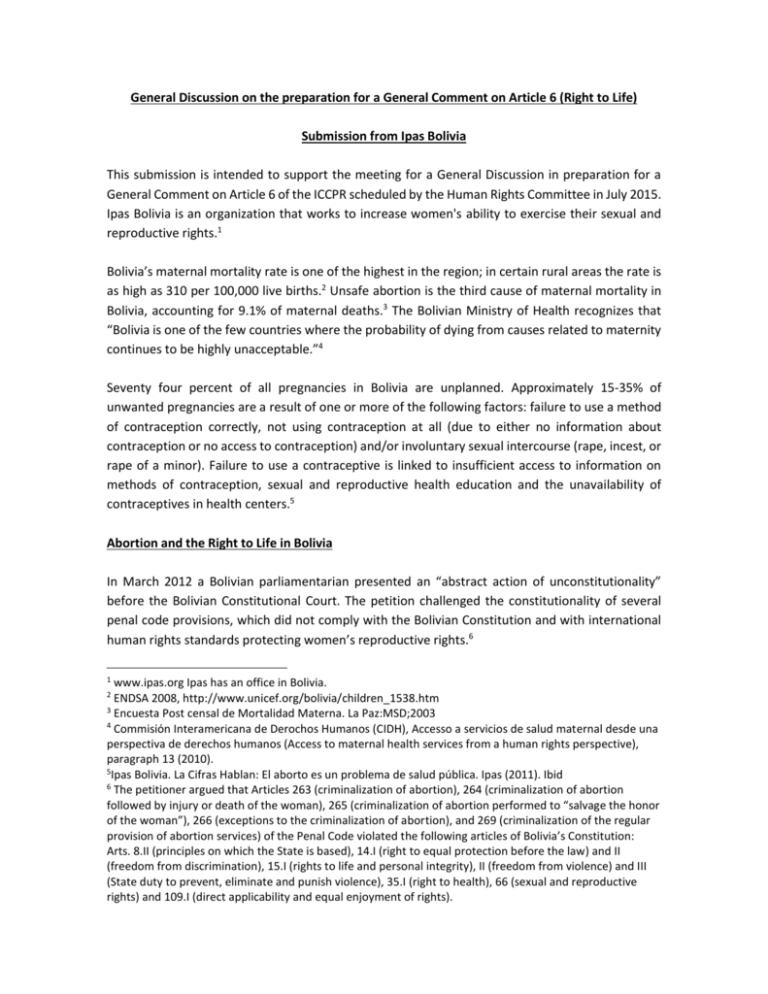
General Discussion on the preparation for a General Comment on Article 6 (Right to Life)
Submission from Ipas Bolivia
This submission is intended to support the meeting for a General Discussion in preparation for a
General Comment on Article 6 of the ICCPR scheduled by the Human Rights Committee in July 2015.
Ipas Bolivia is an organization that works to increase women's ability to exercise their sexual and
reproductive rights.1
Bolivia’s maternal mortality rate is one of the highest in the region; in certain rural areas the rate is
as high as 310 per 100,000 live births.2 Unsafe abortion is the third cause of maternal mortality in
Bolivia, accounting for 9.1% of maternal deaths.3 The Bolivian Ministry of Health recognizes that
“Bolivia is one of the few countries where the probability of dying from causes related to maternity
continues to be highly unacceptable.”4
Seventy four percent of all pregnancies in Bolivia are unplanned. Approximately 15-35% of
unwanted pregnancies are a result of one or more of the following factors: failure to use a method
of contraception correctly, not using contraception at all (due to either no information about
contraception or no access to contraception) and/or involuntary sexual intercourse (rape, incest, or
rape of a minor). Failure to use a contraceptive is linked to insufficient access to information on
methods of contraception, sexual and reproductive health education and the unavailability of
contraceptives in health centers.5
Abortion and the Right to Life in Bolivia
In March 2012 a Bolivian parliamentarian presented an “abstract action of unconstitutionality”
before the Bolivian Constitutional Court. The petition challenged the constitutionality of several
penal code provisions, which did not comply with the Bolivian Constitution and with international
human rights standards protecting women’s reproductive rights.6
1
www.ipas.org Ipas has an office in Bolivia.
ENDSA 2008, http://www.unicef.org/bolivia/children_1538.htm
3
Encuesta Post censal de Mortalidad Materna. La Paz:MSD;2003
4
Commisión Interamericana de Derochos Humanos (CIDH), Accesso a servicios de salud maternal desde una
perspectiva de derechos humanos (Access to maternal health services from a human rights perspective),
paragraph 13 (2010).
5
Ipas Bolivia. La Cifras Hablan: El aborto es un problema de salud pública. Ipas (2011). Ibid
6
The petitioner argued that Articles 263 (criminalization of abortion), 264 (criminalization of abortion
followed by injury or death of the woman), 265 (criminalization of abortion performed to “salvage the honor
of the woman”), 266 (exceptions to the criminalization of abortion), and 269 (criminalization of the regular
provision of abortion services) of the Penal Code violated the following articles of Bolivia’s Constitution:
Arts. 8.II (principles on which the State is based), 14.I (right to equal protection before the law) and II
(freedom from discrimination), 15.I (rights to life and personal integrity), II (freedom from violence) and III
(State duty to prevent, eliminate and punish violence), 35.I (right to health), 66 (sexual and reproductive
rights) and 109.I (direct applicability and equal enjoyment of rights).
2
In response, on February 5, 2014 the Constitutional Court removed from the penal codes the judicial
authorization requirement for an abortion, and in cases of rape or incest, the requirement to file a
criminal complaint. The Court also reaffirmed the constitutionality of abortion in cases of risk to the
health or the risk to life of a woman, this, in accordance with Bolivia’s legal obligations established
in ratified international human rights treaties.7
However, following the Court’s decision, sexual violence survivors with unwanted pregnancies
resulting from rape or incest must still report their rapes to the public prosecutor’s office and law
enforcement authorities in order to access a legal abortion.
Access to legal abortion in cases of rape in Bolivia was highly restricted because of the judicial
authorization requirement and due to providers’ refusal to administer a legal abortion. Since the
Court’s decision, sexual violence victims’ access to abortion care continues to be extremely limited
due to lack of implementation by the Bolivian government, especially adolescent victims of sexual
violence.
Most importantly, although the ruling states a legal obligation to protect life, it says that this
protection is gradual and increases as gestation progresses. In other words, the closer the fetus is to
an embryo the less protection it has under the law. If an embryo is recognized as having the potential
for life but not as actually being alive until it is further along in gestation, then this ruling could open
the door to legal abortion on demand in the first trimester.8
International Human Rights and the Right to Life
International and regional human rights treaties do not recognize the right to life before birth. Below
is a list of major human rights treaties that address the right to life. It is noteworthy that, in addition
to Article 6 of the Covenant, other international human rights treaties and agreements protect the
right to life only after birth:
-
7
The Universal Declaration of Human Rights 9
The International Covenant on Civil and Political Rights10
Regarding the Article 266 (exceptions to the criminalization of abortion), the Tribunal’s decision declared
its constitutionality establishing that woman’s consent is required for the termination of the pregnancy and
that the procedure must be performed by a physician in order to guarantee the life of the woman in such
cases
8
Constitutional decision . Funsamento legal III.8.7
9
Article 1, “All human beings are born free and equal in dignity and rights.” The language of the treaty was
specifically chosen to apply rights to persons once they are born. As the language of the treaty was being
negotiated, an amendment was proposed to include the right to life before birth but the amendment was
overwhelmingly rejected
10
Protects the right to life in Article 6. As with negotiations on the language of the Universal Declaration on
Human Rights, an amendment to protect life before birth was offered and rejected. The Committee
The Convention on the Elimination of All Forms of Discrimination Against Women11
The Convention on the Rights of the Child 12
Regional human rights instruments likewise protect the right to life after birth:
-
The European Convention on the Protection of Human Rights13
The American Convention on Human Rights14
The African Charter on Human and People’s Rights
None of the global or regional instruments protect prenatal life as part of the right to life.
Under international human rights law protection is not given to unborn life, since it is may restrict
the rights of pregnant women. International and regional human rights authorities have not
considered the right to life to apply until after a person is born.
We hope this information can be useful for your discussion on this topic in July.
Malena Morales
Ipas-Bolivia
Gretzel Brozovich
Ipas-Bolivia
overseeing the treaty has recognized the right to abortion and linked it with the right to life of a pregnant
woman
11
Notes the UDHR proclamation that “ are born free and equal in dignity and rights.” The Committee
overseeing the treaty has also recognized that women’s rights include access to safe abortion. General
Recommendation 24 on Health states, “When possible, legislation criminalizing abortion should be
amended, in order to withdraw punitive measures imposed on women who undergo abortion” and the
Committee has repeatedly recommended that states that are party to the treaty take measures to increase
access to safe abortion.
12
Protects the right to life of children after birth under Article 6 which recognizes “that every child has the
inherent right to life.” The preamble of the treaty states "the child, by reason of his physical and mental
immaturity, needs special safeguards and care, including appropriate legal protection, before as well as after
birth," which includes support for pregnant women but not legal protections for fetuses. That the treaty
does not protect life before birth is supported by the Committee on the Rights of the Child’s interpretation
of the treaty to include the right to safe abortion. In General Comment 4, the Committee urges states
parties “to develop and implement programmes that provide access to sexual and reproductive health
services, including family planning, contraception and safe abortion services …” In reviewing states’
compliance with the treaty, the Committee has expressed concern with high rates of unsafe abortion and
has asked governments to review restrictive abortion laws.
13
Base its protection for the right to life on the Universal Declaration on Human Rights. The European Court
of Human Right, in its jurisprudence, has repeatedly denied the right to life of fetuses.
14
Rights is the only international human rights instrument to mention the right to life before birth,
protecting the right to life “in general, from the moment of conception.” The Interamerican Commission on
Human Rights has refused to afford the right to life to a fetus, referring to the American Declaration on the
Rights and Duties of Man, which, like the UDHR, protects rights after birth and emphasizing the clause, “in
general” to be a limit on the right to life before birth.



